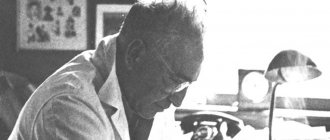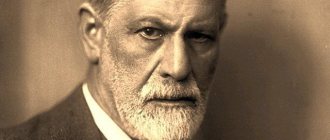When it comes to theories of personality, and, in particular, about psychoanalysis, then, following Sigmund Freud, experts invariably recall the Austrian scientist Alfred Adler. Although he joined Freud’s students at the beginning of his career, he subsequently created his own psychological theory, called individual psychology, according to which the basis of human behavior is determined not by biological prerequisites, but by social ones.
Childhood and youth
The psychologist was born on February 7, 1870 in Rudolfsheim, a village on the western outskirts of Vienna, in Austria-Hungary. He is the second of seven children of Paulina (nee Beer) and Leopold Adler, both Jewish.
Posted by Alfred Adler Tuesday, November 27, 2012
Alfred Adler in his youth
Alfred Adler's biography was complex, full of tragedies and deaths from an early age. In infancy he suffered from rickets, which is why he learned to walk late. At the age of 3 he lost his younger brother, who died next to him in the crib. At the age of 4 he contracted such serious pneumonia that the doctors said: the boy was lost. According to the man’s recollections, it was this quote that inspired him to become a doctor.
Everything stated in Adler’s writings was based on his personal life. As a child, the psychologist was popular with his peers and found in them those feelings of respect and equality that the family did not provide. He later wrote that it is thanks to the interest of society that a person can realize his potential.
The connection between birth order and human personality
Many people wonder how birth order affects the character and future fate of a child. While exploring the childhood experiences of his patients, Adler became interested in the connection between birth order and human personality. Depending on how the child was born, he may have certain characteristics. A. Adler discovered that older, middle and younger children, due to differences in their position in the family, have different social experiences and, as a result, have different personality structures.
Alfred Adler identified the following ordinal positions of a child in a family: only child, eldest child in the family, middle child, youngest of two children, youngest of three or more children. So, let's consider Adler's birth order, and the traits that will belong to children in the family, depending on the birth order.
The only child in the family
For the only child in the family, the most important task is to understand adults. By solving this problem, he develops his ability to understand other people. It is characterized by a heightened sense of good and evil and high motivation to achieve. He loves solving problems and finding different ways to solve them.
Only children feel unique. They demand a lot from life and strive to meet the expectations of their parents. They are characterized by a high level of self-esteem. Only children have more opportunities for intellectual improvement.
There is a risk of attachment, learned helplessness. Being in the power of parental care, the child is practically never left to himself. He has little opportunity to independently build his relationships with others. Depending on the degree of parental care, two types of only children are distinguished: early maturing and “mama’s boy”.
The first child in the family, i.e. firstborn
The eldest child goes through three stages in his development: 1. He is the only one, unique, in the focus of his parents’ attention, in a privileged position. 2. With the birth of the youngest child, the situation changes dramatically. If the eldest is not 5-6 years old at this time, then the birth of a brother or sister can cause severe stress. Parents switch to the baby, the older child loses power over them. Envy and competition between children are possible, and this reaction of the first child to the appearance of the younger one is stronger if the second child is of the same sex. 3. At the third stage, the child finds a way out of the current situation. He believes that he should be stronger and smarter than the younger child. This decision is reinforced by the behavior of the parents: they understand that the eldest is given too little time and attention. Therefore, they tell him that compared to a baby, he is already smart enough to do many things on his own, without the help of adults.
Thus, the eldest children in the family are the center of attention for some time - but only until the next child appears, who will now attract all the attention of the parents. Therefore, the first-born may begin to feel insecure and hostile, losing his previous sense of security. The result of these changes can also be authoritarianism and conservatism, a rigid desire to maintain order by any means. Adler suggested that it is often the first-born in the family who become criminals, neurotics and perverts.
Older children follow the rules, strive for perfection, success and most often achieve it, and if not, then they give up what they started. These are usually obedient, rule-following children. They are conscientious, serious, stubborn, responsible, and the sense of responsibility may be too high. They are intolerant of other people's mistakes and at the same time very sensitive to the comments of others and changes in relationships.
Middle child in the family
The position of the middle child in birth order is the least studied; Apparently, it is these children who most often have difficulties with self-determination, due to the fact that they are both older and younger and therefore combine the features of both.
Lack of attention from parents often results in the middle child feeling abandoned and therefore sometimes picking up annoying, attention-seeking habits. Some researchers believe that middle children learn to get along with everyone, becoming friendly and tactful towards others.
Second child in the family (younger of two children)
According to Adler, the second child is often ambitious, rebellious and jealous: after all, he is always faced with the task of not only keeping up with, but also surpassing his older brother or sister. Adler believed that it was the second child who was better adapted to life than the older or younger child. After all, younger children, as a rule, are spoiled in the family, and therefore they are more likely to have problems than others. They are more self-oriented than other-oriented and do not particularly strive to meet the expectations of others.
This child is the complete opposite of the older one. He is characterized by independence and optimism. The younger of the two children shifts responsibility for everything that happens to the others. He is manipulative in his relationships with people. It is difficult for him to keep up with his elder, who is academically oriented, so he decides to beat him in another field where he is not strong (usually sports or art).
Youngest of three or more children
To develop relationships with others, especially with their own brothers and sisters, they can either pretend to be children all their lives, or find a way to get ahead of others. These children may be the luckiest of all. They are creative individuals and are often incomprehensible to others. Their gaze is directed to the future. They often make good leaders.
By the time the youngest child was born, parents could already have formed their own views on upbringing. Therefore, it can be assumed that in relation to the younger, the tactics of educational influence will be more consistent than in relation to the older. Therefore, the youngest of several children will be more emotionally stable than the older children.
Personal life
During his student years, Alfred met his future wife Raisa Timofeevna Epshtein, an intellectual and socialist from Russia who came to Vienna on exchange. The wedding took place in 1897.
Alfred Adler With Son Kurt and Daughter Alexandra (1936, in California)
Published by Alfred Adler Tuesday, November 27, 2012
Alfred Adler with his son Kurt and daughter Alexandra
The marriage produced children: Valentina (b. 1898), Alexandra (b. 1901), Kurt (b. 1905) and Cornelia, or Nellie (b. 1909). ). The archives contain many photographs of the friendly Adler family.
The middle children, Alexandra and Kurt, followed in their father’s footsteps and connected their lives with psychiatry. Valentina chose the path of her mother - she became a Trotskyist, for which she was later repressed.
Main works
He founded Adler's Association for Individual Psychology, which was originally called the Society for Free Psychoanalytic Research. His work was dominated by a holistic approach to the study of human psychology and personality. He identified several fictitious goals, which are mostly unconscious. Adler was convinced that human psychology was psychodynamic and could be explained telelogically. He also believed that the conscious and unconscious worked in tandem to achieve fictitious goals. Adler believed that the inferiority complex has an extremely strong influence on determining the development of a person’s personality. He also thought that inferiority complex was a major factor in behavior problems in children.
Scientific activity
Alfred Adler began his medical career as an ophthalmologist, then switched to neurology, but his interest in psychology still prevailed. His ideas turned out to be so interesting that in 1902, Sigmund Freud invited a colleague to join his discussion club Wednesday Society. In fact, psychoanalysis was born at these meetings.
Like many people, Adler's relationship with Sigmund Freud did not work out. In 1911, he left the Wednesday Society, and a year later founded the Association for Individual Psychology. Initially, he was joined by those who considered Alfred's ideas more similar to the philosophy of Friedrich Nietzsche than to Freud's psychoanalysis.
The thinker succeeded in building an independent school of psychotherapy and personality theory. His main goal was to develop a concept that would consider a person’s psychological well-being in connection with his social status. At the same time, Adler wisely emphasized not on treating existing problems, but on preventing their occurrence.
The man's early ideas are described in the book The Neurotic Character. Already on these pages the concepts of inferiority and compensation appear.
The psychologist writes that the unconscious of a person free from mental problems works in such a way as to transform existing inferiority - physical, moral, mental - into superiority, that is, completeness. Only social barriers can stand in the way of this transformation: upbringing, environment, role in society. Adler also points out the danger of “overcompensating.” A person who achieves this becomes, as a rule, a power-hungry, aggressive egocentric.
In his concept, Alfred devotes a significant place to childhood memories. In the book “The Science of Living,” the psychologist writes:
“Memories are reminders. There are no random memories. Of the innumerable number of impressions that happen to a person in childhood, memory prefers to store only those that it considers to be an explanation of mental problems.”
Adler was also interested in the order in which children were born. Relying on his own experience, he suggested that the first-born is in a favorable position because he alone enjoys the attention of his parents. But with the advent of his second and subsequent children, he begins to feel humiliated. An inferiority complex develops.
Published by Irene Giuntini Wednesday, September 11, 2019
Alfred Adler, Sigmund Freud and Carl Gustav Jung
According to the thinker, it is older children who most often suffer from neurosis and bad habits. This is compensation for excessive responsibility in childhood - for example, the need to look after relatives. Younger children, on the contrary, grow up spoiled, which leads to weak social empathy. But middle children, who have not experienced either excessive attention or lack thereof, most often grow into successful people.
That is why Adler considered it important to conduct therapy and training not with adults who are mentally ill or even with children, but with those involved in education. For 25 years, the psychologist lectured in schools, hospitals, and community centers. He told parents, social workers, and teachers how to raise a worthy member of society.
Part of these lectures are recorded in Adler’s bibliography: “Individual psychology as a path to human knowledge and self-knowledge,” “Understanding human nature,” “On the desire for superiority.”
It is difficult to appreciate the practical contribution to psychology made by Alfred Adler. I can’t count how many people he saved from inferiority complexes and subsequent painful compensation.
Some of the thinker’s views found a response in neo-Freudianism and Gestalt psychology, and they are still relevant today. His personality theory is followed in dozens of countries: the USA, Canada, Austria, Germany, Italy, Israel, Japan, etc.
Individual Psychology of Alfred Adler
Alfred Adler was born in Vienna on February 7, 1870, the third of six children. Like Freud, he was the son of a middle-class Jewish merchant. However, while Freud grew up in a ghetto-like area and retained his identity as a persecuted minority throughout his life, Adler accepted his ethnic origin easily. There were few Jewish children in the area where he grew up, and so his accent and outlook were more Viennese than Jewish. Unlike Freud, who often returned to this topic, Adler made no statements about anti-Semitism, and in his mature years he accepted the Protestant faith. Adler described his childhood as a difficult and unhappy time. He enjoyed his mother's love during the first two years of his life, but the time of tenderness ended with the birth of his younger brother. Then he acquired a special favor from his father, whose favorite he remained throughout his childhood. In his early years he was constantly surrounded by illness and death - when he was three years old, his younger brother died in the bed next to his. In addition to this, he twice narrowly escaped the prospect of being killed in street incidents. At the age of five he contracted a severe form of pneumonia and came very close to death. He later attributed his desire to become a doctor to this near-fatal disease.
In the first grades of school, Adler was a very mediocre student. He failed in mathematics and was forced to repeat the second year. The teacher advised his father to take his son out of school and apprentice him to a shoemaker, since he was apparently incapable of anything else. However, his father encouraged his son to continue his studies, and through persistence and hard work, Adler became the top math student in his class.
At the age of 18, Adler entered the University of Vienna, which at that time was one of the leading European medical centers. The life of the theater, music and political philosophy of the socialists was seething around, and therefore the city became famous as the “red” Vienna. During his student years, Adler selflessly plunged into politics. He became interested in socialism and participated in many political meetings. At one of them, he met his future wife, Raisa Epstein, a student from Russia who also studied at the University of Vienna. In 1897 they got married.
Adler received his medical degree in 1895. For some time after this he specialized in ophthalmology, working in a seedy part of the city. Then, after completing an internship in general medicine, he became a psychiatrist. From 1902 to 1911 he was an active member of the circle formed around Sigmund Freud. But Adler soon began to develop ideas that differed from the ideas of Freud and his supporters. His views became increasingly incompatible with Freud's position. In 1911, Adler resigned as president of the Vienna Psychoanalytic Society and left it. At the same time, 9 of the 23 members with whom he founded the Society of Free Psychoanalysis left the Society - mostly out of a desire to annoy Freud and some of his devoted associates. The following year, 1912, the name of the Adlerian society was changed, and it became the Society for Individual Psychology.
Since the mid-20s, Adler has been devoting more and more time to traveling around Europe and the United States. When a wave of totalitarianism swept across Europe with Hitler's rise to power, he foresaw the catastrophe and realized that if psychology would survive anywhere, it would be only in America. In 1935, Adler and his wife settled in New York. Shortly thereafter, he accepted a position as a practicing professor of medical psychology at Long Island Medical College (now the State University of New York Southern Medical Center) and continued his private psychiatry practice. Two of Adler's four children, Alexandra and Kurt, became psychiatrists, like their father.
Adler was a tireless lecturer. He delivered his lectures with ease and was very popular. On May 28, 1937, during a lecture tour, Adler suddenly died in the Scottish city of Aberdeen. When Freud learned of his death, he wrote to his friend, who was very upset by this news: “I do not understand your sympathy for Adler. For a Jewish boy from a suburb of Vienna, death in Aberdeen is in itself an unheard of career and proof of how he has succeeded. In fact, the world rewarded him generously for his efforts in the field of refuting psychoanalysis” (Jones, 1957, p. 208).
Adler was a prolific and active writer. During his life he wrote about 300 books and articles. Perhaps the best introduction to his theory of personality is The Practice and Theory of Individual Psychology (1927a). Among his many other significant works made available through translation into English are The Neurotic Constitution (1917a); "A Study of Physical Inferiority and its Mental Compensation" (1917b); "An Understanding of Human Nature" (1927b); "The Science of Life" (1929); "Way of Life" (1930); "The Meaning of Life" (1931); "The Social Interest: A Challenge to Humanity" (1939). Adler's followers founded many professional journals with the aim of disseminating theoretical and experimental works on individual psychology. These include the Journal of Individual Psychology, the American Journal of Individual Psychology, and the International Journal of Individual Psychology.
Adler's ideas have a powerful influence on modern research in clinical and individual psychology. The emphasis placed in his theory on social interest as an essential criterion of mental health contributed to the emergence of the concept of value orientations in psychotherapy. In addition, his focus on conscious, rational processes stimulated the emergence of ego psychology (Ansbacher, 1977). His concept of the essential role of social forces in the development of personality is recognizable in the later work of Erich Fromm, Karen Horney and Harry Stack Sullivan - all who noted the lack of sociological orientation in Freud's theory. Accordingly, emphasizing the strong-willed and creative aspects of personality has directly and indirectly influenced such prominent psychologists as Gordon Allport, Abraham Maslow, Rollo May, Viktor Frankl, and Albert Ellis. This chapter provides many examples of the modern sound of many of Adler's concepts. Among them are such as the need for an adequate theory, a feeling of inferiority and compensatory efforts, organ failure and psychosomatics, an “inferiority complex” (a characteristic so often used in our time - a harbinger of the psychology of somatic illnesses), the role of rejection in the development of an antisocial personality; competence as a sign of maturity; self-esteem and desire for power; lifestyle concept; stress and adaptation; birth order; self-display and usefulness to others; mental health, creativity, and many others. An excellent introduction to Adler's theoretical concepts can be found in the work of Manaster and Corsini (1982).
Basic theses of individual psychology:
Adler is often presented as a student of Freud who eventually rebelled against his teacher and began to create his own concepts. However, a careful examination of his life and work shows that he was in fact a colleague of Freud, and should in no way be perceived as a “neo-Freudian.” In his early works, where the germs of future theories are discerned, he is very critical of the period of collaboration with Freud (Ellenberger, 1970). Moreover, Adler never studied under Freud and was never psychoanalyzed himself, which is a prerequisite for becoming a practicing psychoanalyst (Orgler, 1972). Unfortunately, Adler and Freud were not reconciled after the breakdown of their relationship in 1911, and Freud remained hostile to Adler throughout his life. As a discussion of Adler's basic concepts will show, most of the provisions of his individual psychology developed as antitheses of Freud's theory.
1. The individual as a single and self-consistent whole
The idea that man is a unified and self-consistent organism is the main premise of Adlerian psychology (Adler, 1927a). Adler gave his theory the name "individual psychology" because in Latin "individuum" means "indivisible" - that is, it means an entity that cannot be divided. Adler proceeded from the fact that not a single manifestation of life activity can be considered in isolation, but only in relation to the personality as a whole. The individual is an indivisible whole, both in relation to the relationship between the brain and the body and in relation to mental life. According to Adler, the main requirement for individual psychology is to prove this unity in every individual: in his thinking, feelings, actions, the so-called consciousness and unconscious, in every manifestation of personality. Adler defined the structure of a self-consistent and unified personality as a lifestyle. This concept, more than any other, expresses his attempt to consider man as a single whole.
2. Human life as an active pursuit of perfection
Considering a person as an organic whole requires a single psychodynamic principle. Adler derived it from life itself, namely from the fact that life cannot be imagined without continuous movement in the direction of growth and development. Only in moving towards personally significant goals can an individual be perceived as a unified and self-consistent whole.
Arguing that a person strives for perfection, Adler proceeded from the consideration that people do not push away from internal or external reasons, but rather pull forward - they are always in motion towards personally significant life goals. The goals that people set for themselves, as well as the individual paths to achieving them, provide clues to the meaning they attach to their lives. According to Adler, these life goals are largely individually chosen, and therefore, in the constant pursuit of excellence, people are able to plan their actions and determine their own destiny. By achieving their goals, they not only increase self-esteem, but also find their place in life.
3. The individual as a creative and self-determining whole
Recognizing the importance of heredity and environment in the formation of personality, Adler insisted that the individual is more than just the product of these two influences (Adler, 1964). Namely, he believed that people have a creative power that provides the ability to manage their lives - free, conscious activity is a defining feature of a person. This creative force influences every facet of human experience: perception, memory, imagination, fantasy and dreams. It makes each person a self-determining individual, the architect of his own life.
It is this conviction in the creative nature and freedom of man, more than anything else, that leads many psychologists to consider Adler the harbinger of modern humanistic psychology.
4. Social identity of the individual
Adler's holistic vision of human nature was comprehensive. He understood a person not only as an integral system of relationships, taken separately, but also as an integral part of larger systems - family, community: “Individual psychology considers and studies the individual included in society. We refuse to consider and study man in isolation from him” (Adler, 1956, p. 2). The leading position in Adler's theory is the position according to which all human behavior occurs in a social context, and the essence of human nature can only be comprehended through an understanding of social relations. Moreover, every person has a natural sense of community, or social interest - an innate desire to enter into mutual cooperative social relationships. Thus, individual psychology believes that harmony of unification and cooperation between a person and society is necessary, and considers conflict between them unnatural. The emphasis on the social determinants of behavior is so important in Adler's concept that he gained the reputation of being the first social psychologist in modern psychological theory.
5. Individual subjectivity
Firmly in the phenomenological tradition, Adler believed that behavior always depends on people's opinions about themselves and about the environment in which they must fit. People live in a world of their own creation, in accordance with their own “scheme of apperception.” Adler further argued that people are motivated by fictitious goals—personal opinions about present and future events that govern their behavior. For example, a person may be guided in his life by the credo “honesty is the best policy,” or “every man for himself,” or by the belief that in the afterlife, virtue will be rewarded and vice punished. Adler believes that people behave in accordance with these personal beliefs, regardless of whether they are objectively real or not: “A poisonous snake creeps up to my foot or I just think that it is poisonous - the effect will be the same” (qtd. . after Ansbacher, 1971, p. 58). In Adler's scheme, behavior clearly reflects the individual subjective perception of reality. Next, we will consider the central theoretical concepts developed on the basis of these principles of individual psychology.
Death
Alfred Adler died on May 28, 1937 in Aberdeen, Scotland. The cause of death was a heart attack. They say he became ill on the street. Passersby who came to help heard the name fall from his lips: “Kurt.” At the dying minute, the man called for his only son.
The body was incinerated at Warriston Crematorium in Edinburgh, but was never released to the family. For many years, the remains of the psychologist were considered lost, and in 2007 they were found in the crematorium vaults. In 2011, the urn with the ashes was transported to Vienna for burial.
"The Science of Living"
In fact, it should be taught in high schools and universities. The science of living must be learned while in adolescence. Alfred Adler emphasizes that not everyone masters the art of correct and harmonious existence. Many people never think about the reasons for their actions, do not know how to analyze the present and accept the lessons of fate. Adler reveals to the reader the true motives of internal conflicts, prolonged stress, leading to depression.
“The Science of Living” explains why some people cannot achieve happiness, although they have been striving for it for many years, while others, even in the absence of important components of financial well-being, are in a state of harmony with themselves and their inner essence. This idea is emphasized in the text by Alfred Adler. The psychology of individuality receives maximum disclosure in this book.
Individual Personality Theory Concept
Adler identified six principles:
- fictitious finalism
- striving for excellence
- feeling of inferiority
- public interest
- life style
- creative “I”
The essence and principles are reflected in 1920 in the analytical study “The Theory and Practice of Individual Psychology.”
The concept reduces all emphasis on the subjective integrity of the face. Denying the existence of a confrontation between the conscious and the unconscious. Freud thought the opposite. This difference of opinion finally broke off the relationship between scientists eight years ago before the book was published.
The presence of creativity in a conscious form is an important aspect of the concept. The creative “I” takes the place of a guiding vector in the process of personality development. Can adapt to the conditions of life experience and give it a semantic assessment. According to which the direction of personality development changes. In addition, the task of the “creative self” is to search for the necessary experience. Which confirms: everyone is the architect of their own happiness. More precisely, a life scenario. Representing nothing more than a creative act.
According to the concept, a life style model is formed in a person before the age of five. This is why there is a logical emphasis on the importance of family presence. The conditions of which form the structure of the individual.
Pleasure cannot be an end in itself. The goal is to pursue perfection.
1900-1937 - friendship and conflict with Freud, emigration to the USA
Adler began his medical practice as a 25-year-old ophthalmologist. After completing general medical practice, he chose to specialize in psychiatry. At the beginning of the twentieth century, he accepted Freud's invitation and became a member of the circle of psychoanalytic theory.
In 1910, 40-year-old Dr. Albert was elected President of the Vienna Psychoanalytic Society. A conflict with Freud soon forced him to leave this position. Following on from the 23, 9 of its participants left. Who, together with Adler, subsequently registered the new “Society for Free Psychoanalysis”. And in 1912 it was renamed the “Society of Individual Psychology”.
Since the 1920s, he has been traveling with foreign lectures on psychiatry. Which are held with stunning success in the USA. Nazi power in Europe forced Adler to remain in New York. The scientist clearly understood: psychiatry will survive only on this continent. In 1932, Adler and Raisa Epstein finally moved to America for permanent residence. Where does he practice private medicine? At the same time he is a professor at Long Island University.
On May 28, 67-year-old Professor Adler becomes ill with his heart during a lecture. I failed to recover. The death happened unexpectedly. He was buried in the cemetery of Aberdeen, Scotland.
Personality theory
Its fundamental principles are revealed in two works: “On Nervous Character” (1912) and “Study of Physical Inferiority and Mental Compensation” (1917).
The theory represents the first psychological personality typology.
The key message of the teaching is a compensatory mechanism. Compensation helps develop three innate unconscious feelings:
- community
- inferiority
- striving for superiority
A sense of community sets the vector for lifestyle. The skeleton on which the structure rests. Two feelings: inferiority and the desire for superiority are carriers of energy important for the harmonious development of the individual.
Adler divided the compensatory mechanism into four categories:
1) Incomplete
Occurs in the absence of complete realization (examples of the presence of external deformities).
2) Full
That is, the defect is perceived as a selective individuality. A person strives not to become better than others, but to be no worse.
3) Overcompensation
A human defect does not give rise to aggressive actions. The person strives to benefit society. A striking example: the 32nd American President Franklin Roosevelt and the Greek philosopher Demosthenes.
In the case of an undeveloped sense of community, the principle of the compensatory mechanism works in the opposite way. The defect serves as a source of aggression: a person strives for power with all the ensuing consequences. Adler cited Hitler, Suvorov, and Napoleon as examples.
4) Imaginary
Leads to defect speculation.








